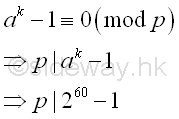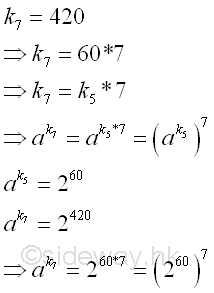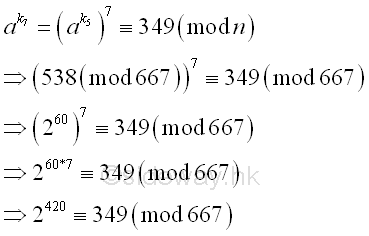Content
Pollard's p-1 Method
Pollard's P-1 Methed by
PowerSmooth Number
Pollard's P-1 Methed by
PowerSmooth Number Example 2
Pollard's p-1 Method
Pollard's p-1 method is a prime factorization algorithm discovered by John Pollard in 1974. Limited by the algorithm, the Pollard's p-1 method is only work for integers with specific factors.
If the number n has a prime factor p such that p-1 can be expressed in terms of a product of primes, the finding of prime factor p is based on the selected boundary B of the B-powersmooth number. The algorithm fails when the selected boundary B is smaller than the B-powersmooth number of p-1.
Pollard's P-1 Methed by PowerSmooth Number
Pollard's P-1 Methed by PowerSmooth Number Example 2
For example: n=667=p*q=23*29; let B=5 imply
| Integer | B-smooth number | Prime Factors | number |
|---|---|---|---|
| k | 5 | 22*31*51 = 4*3*5 | 60 |
Therefore for B=5, k5 or (p5-1)m5 is equal to 60.
Fermat's Little Theorem
let a=2, by Fermat's little theorem, let p be one of the prime factors of n, imply p idivides ak-1.

Greatest Common Divisor
Since ak-1 is a very large number, before finding the greatest common divisor of n and ak-1, ak-1 can be raised to the high power modulo n. Imply
Using squarings modulo
| base | number; a=2; k=60; n=667 |
|---|---|
| ak base 10 | 260 |
| ai base 10 | 21 = 21 ≡ 2 (mod 667) |
| 22 = 22 ≡ 4 (mod 667) | |
| 24 = 42 ≡ 16 (mod 667) | |
| 28 = 162 ≡ 256 (mod 667) | |
| 216 = 2562 ≡ 170 (mod 667) | |
| 232 = 1702 ≡ 219 (mod 667) | |
| ak base 10 | 232+16+8+4 |
| ak base 10 | 232*216*28*24 |
| ak base 10 | 219*170*256*16 ≡ 538 (mod 667) |
and using the residue to calculate the greatest common divisor. Imply

The greatest common divisor of n and ak-1 is
Using Euclid's algorithm
| ak-1 | n |
|---|---|
| 260-1 | 667 |
| 538-1 | 667 |
| 537 | 667-537=130 |
| 537-4*130=17 | 130 |
| 17 | 130-7*17=11 |
| 17-11=6 | 11 |
| 6 | 11-6=5 |
| 6-5=1 | 5 |
| 1 | 5-5*1=0 |
| 1 | 0 |
Imply

The algorithm fails because the greatest common divisor of n and ak-1 is equal to 1. The number n does not have prime divisor p with p-1 is 5-powersmooth. Therefore the bound B equals to 5 fails, a larger bound B' should be used.
Let B=7, imply
| Integer | B-powersmooth number | Prime Factors | number |
|---|---|---|---|
| k | 7 | 22*31*51*71 = 4*3*5*7 | 60 * 7 = 420 |
Therefore for B=7, k7 or (p7-1)m7 is equal to 60*7 = 420. Imply k7 = k5 * 7. And the new ak can be expressed as

And ak can be raised to the high power modulo n, imply

Using squarings modulo
| base | number; a=538; k=7*; n=667 |
|---|---|
| ak base 10 | 5387 (mod 667) |
| ai base 10 | 5381 = 5381 ≡ 538 (mod 667) |
| 5382 = 5382 ≡ 633 (mod 667) | |
| 5384 = 6332 ≡ 489 (mod 667) | |
| ak base 10 | 5384+2+1 (mod 667) |
| ak base 10 | 5384*5382*5381 (mod 667) |
| ak base 10 | 489*633*538 ≡ 349 (mod 667) |
and using the residue to calculate the greatest common divisor. Imply

The greatest common divisor of n and ak-1 is
Using Euclid's algorithm
| ak-1 | n |
|---|---|
| 2420-1 | 667 |
| 349-1 | 667 |
| 348 | 667-348=319 |
| 348-319=29 | 319 |
| 29 | 319-11*29=0 |
| 29 | 0 |
Imply

Integer 29, the greatest common divisor of n and ak-1 is also the prime divisor of n. And p-1 is 7-powersmooth.
| Integer | B-powersmooth number | Prime Factors | number |
|---|---|---|---|
| p-1 | 7 | 22*71 | 28 |
| k | 7 | 22*31*51*71 = 4*3*5*7 | 420 |
| k/(p-1) | 20*31*51*70 | 15 |
©sideway
ID: 120500010 Last Updated: 5/17/2012 Revision: 0
Latest Updated Links
- Travel Singapore Sight Space(last updated On 12/30/2025)
- Travel Singapore Sight Curiosity Cove(last updated On 12/30/2025)
- Travel Singapore Sight Night Safari(last updated On 12/30/2025)
- Travel Singapore Sight River Wonders(last updated On 12/30/2025)
- Travel Singapore Sight Rainforest Wild ASIA(last updated On 12/30/2025)
- Travel Singapore Sight Singapore Zoo(last updated On 12/30/2025)
- Travel Singapore Sight Mandai(last updated On 12/30/2025)
- Travel Singapore Sight Bird Paradise(last updated On 12/30/2025)
- Travel Singapore Sight AltitudeX(last updated On 12/30/2025)
- Travel Singapore Sight(last updated On 12/6/2025)
- Travel Singapore Rail Network(last updated On 12/5/2025)

 Nu Html Checker
Nu Html Checker  53
53  na
na  na
na
Home 5
Business
Management
HBR 3
Information
Recreation
Hobbies 9
Culture
Chinese 1097
English 339
Travel 31
Reference 79
Hardware 54
Computer
Hardware 259
Software
Application 213
Digitization 37
Latex 52
Manim 205
KB 1
Numeric 19
Programming
Web 289
Unicode 504
HTML 66
CSS 65
SVG 46
ASP.NET 270
OS 431
DeskTop 7
Python 72
Knowledge
Mathematics
Formulas 8
Set 1
Logic 1
Algebra 84
Number Theory 206
Trigonometry 31
Geometry 34
Calculus 67
Engineering
Tables 8
Mechanical
Rigid Bodies
Statics 92
Dynamics 37
Fluid 5
Control
Acoustics 19
Natural Sciences
Matter 1
Electric 27
Biology 1
